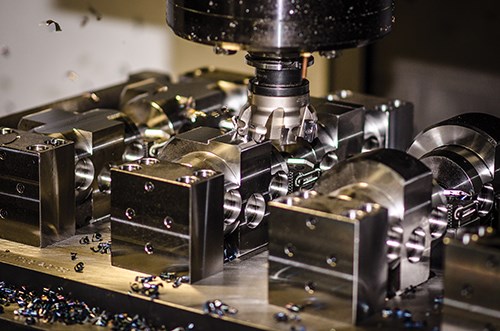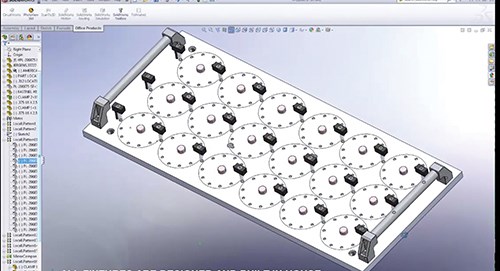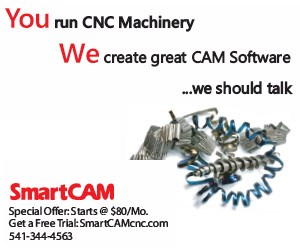Leveraging CAD/CAM for High-Density Machining
CAD/CAM software streamlines the design of high-density fixtures for this machine shop.
J&R Machine Inc. makes critical parts for industries including medical device, industrial equipment, energy and auto racing. The Shawano, Wisconsin, company also takes pride in its workholding fixtures for internal consumption—fixtures designed to make many sides of a part accessible for multiaxis machines while enabling numerous individual parts to be quickly loaded in a single setup. This concept is known as high-density machining, and developing the CAD/CAM expertise to implement it played a major role in J&R’s dramatic turnaround from some significant challenges it faced just a decade ago.
In early 2004, work was drying up due to a sluggish economy and increased offshoring to low-wage countries. Tim Tumanic, J&R’s president, realized that the only option was to go after more complicated, value-added work that was less prone to offshoring. To make this kind of work profitable, the company re-structured its business model from a conventional job shop to a complete manufacturing services business. It also modified its shopfloor processes and started to acquire more advanced equipment.
By 2009, business conditions began to improve. J&R had purchased horizontal machining centers and multiaxis turning centers, and was attracting some of the complex work it had envisioned years earlier. The company also invested in seats of Mastercam CAM software from CNC Software Inc., and Solidworks CAD software. Although it had previously performed its CNC programming manually at each machine, it realized that this new software capability would enable the company to streamline high-density workholding fixture design and toolpath generation for both parts and fixtures.
“Mastercam and Solidworks enabled us to go from print to part much faster,” says Parker Tumanic, J&R’s vice president as well as primary fixture designer and CNC programmer. “By offering shorter lead times, we began to attract a steadier stream of the type of complex work we had established as being our goal.”
For example, one part that used to take Mr. Tumanic 10 hours to program at the machine now took no more than an hour. Not only did this result in a big boost to his personal productivity, it also freed 10 additional hours for the machine tool to be cutting parts. Therefore, the initial investment in CAD/CAM software had the same impact on productivity as adding another CNC machine, he notes.
After taking a year to become proficient with these new software tools, Mr. Tumanic turned his attention to developing J&R’s proprietary internal product line: high-density fixturing. “High-density machining is all about amortizing the cost of tool changes by spreading them over many parts fixtured in a machine during a single setup,” he says. “Making a single part that requires 10 tool changes at 3 seconds per tool change would equal 30 seconds of tool changing time. By fixturing 10 parts in a high-density fixture, the tool change time per part becomes just 3 seconds.
“Every part we make has its own custom fixture,” Mr. Tumanic explains. “We don’t skimp on fixture design and we don’t pad the piece price. There is a one-time charge for the fixture and, in return, the customer gets a lower piece price. For example, if we are running 10,000 parts for a customer, and we are $2 more competitive than another vendor, then that would be a $20,000 savings. If we charged $5,000 for the fixture, our customer would be ahead by $15,000 and would not be continually paying for the fixture as it might be if the fixture was buried in the piece price.”
For each new job that’s a good candidate for high-density machining, Mr. Tumanic imports the part’s CAD model into Solidworks and uses that as the basis for designing a fixture for holding multiple parts. As a result, there are two models: one for the part and one for the fixture. The starting points for the fixture designs are standard fixture bases, pre-defined and available as templates. The models for the part and custom fixture are then imported into Mastercam, which Mr. Tumanic uses to develop the tool paths for making them. Although many parts will be machined during a single setup, he only needs to create the tool paths for making each part and the fixture once. After these programs are completed, he can simply populate them across the workholding plate in a series of cut-and-paste operations.
Mr. Tumanic then uses Mastercam’s offline Machine Simulation feature to ensure that there are no clearance issues that would cause a crash. If the simulation reveals a clearance issue, he may change the tool path at that position, use a different tool or use Solidworks to change the design of the workholding device.
J&R uses the high-density approach as often as possible, designing custom fixtures to accommodate as many as 100 parts in a single setup. Mr. Tumanic says this can reduce per-part cycle times by as much as 30 to 90 percent, depending on the part. In addition, a well-designed custom fixture reduces potential for operator loading error. It also makes it possible to reach more areas on the part with fewer operations and provides a more rigid workholding solution, making it possible to hold tighter tolerances. Plus, because total machine cycle times for a single setup are much longer, operators can monitor two or three machines instead of just one.
J&R is also continually on the lookout for additional ways to improve its manufacturing processes. One of its allies in this pursuit is ShopWare, its local Mastercam reseller. Mr. Tumanic consults with ShopWare whenever he comes across a machining issue, and the reseller has also conducted on-site training for the company. In 2012, J&R asked ShopWare to consult on a special project that involved developing a high-density machining process for its horizontal machining center to make complex six-sided parts that required multiple tool changes and multiple offsets.
Based on the efficiencies obtained, J&R won a long-term contract that now contributes about 2,000 hours of machining work each year. In addition, at ShopWare’s recommendation, J&R will soon install a seat of Mastercam for Solidworks, in which Mastercam will reside on a menu within Solidworks. This will enable Mr. Tumanic to make fast iterative changes to both fixture designs and fixture manufacturing processes. It will also enable him to produce better fixture designs and manufacturing processes, while reducing first-part lead times.
The custom fixture design and manufacturing efforts have proven to be so valuable that Mr. Tumanic has identified nearly 100 high-density fixture projects that will result in improved machining productivity for both new and existing parts. Over the past five years, sales at J&R Machine have approximately doubled to $10 million as a result of high-density fixturing and other improvement efforts. Labor costs have been reduced from 18 to just 10 percent of income. Plus, the company is getting almost twice as much done with just 30 employees who are, in turn, appropriately rewarded for their contributions. In fact, the machinist who has been most active in fixture manufacturing will soon be trained to work with Mr. Tumanic full time as a fixture designer and CNC programmer, which should push the company’s labor-costs-to-sales ratio even lower.
Related Content
Large-Format Machining With Small Cutting Tools and Dynamic Motion
Napoleon Machine, a defense contractor that provides parts for the M1 Abrams tank, recently took advantage of a CAM feature that allowed the company to streamline its cutting strategies and program offline. Here’s how the shop cut cycle times nearly in half with its large-format five-axis machining operations.
Read MoreFearless Five-Axis Programming Fosters Shop Growth
Reinvestment in automation has spurred KCS Advanced Machining Service’s growth from prototyping to low-and mid-volume parts. The key to its success? A young staff of talented programmers.
Read MoreCan ChatGPT Create Usable G-Code Programs?
Since its debut in late 2022, ChatGPT has been used in many situations, from writing stories to writing code, including G-code. But is it useful to shops? We asked a CAM expert for his thoughts.
Read MoreWhen to Use Custom Macros With a CAM System
Custom macros can offer benefits even when using a CAM system to prepare programs – but must be implemented with the right considerations.
Read MoreRead Next
The Cut Scene: The Finer Details of Large-Format Machining
Small details and features can have an outsized impact on large parts, such as Barbco’s collapsible utility drill head.
Read More3 Mistakes That Cause CNC Programs to Fail
Despite enhancements to manufacturing technology, there are still issues today that can cause programs to fail. These failures can cause lost time, scrapped parts, damaged machines and even injured operators.
Read More
.jpg;width=70;height=70;mode=crop)


































